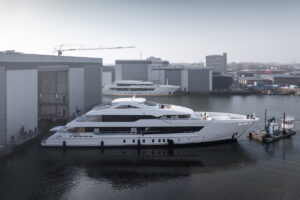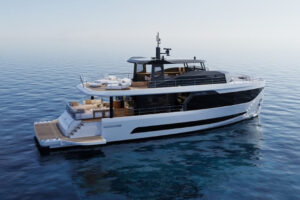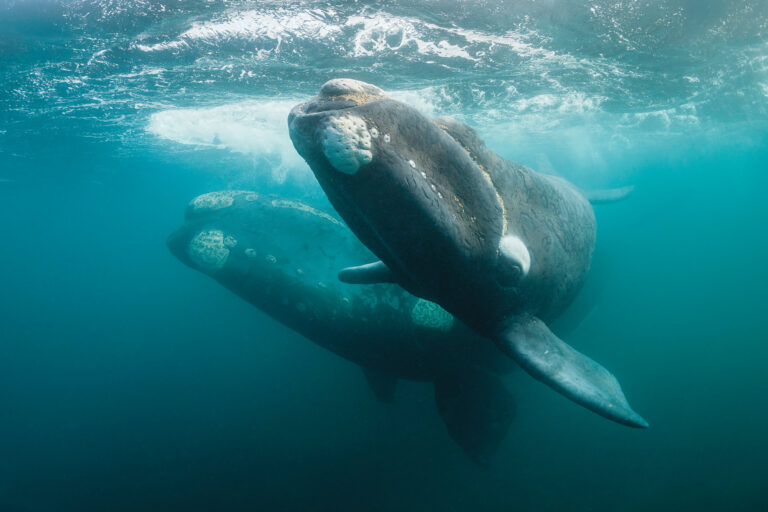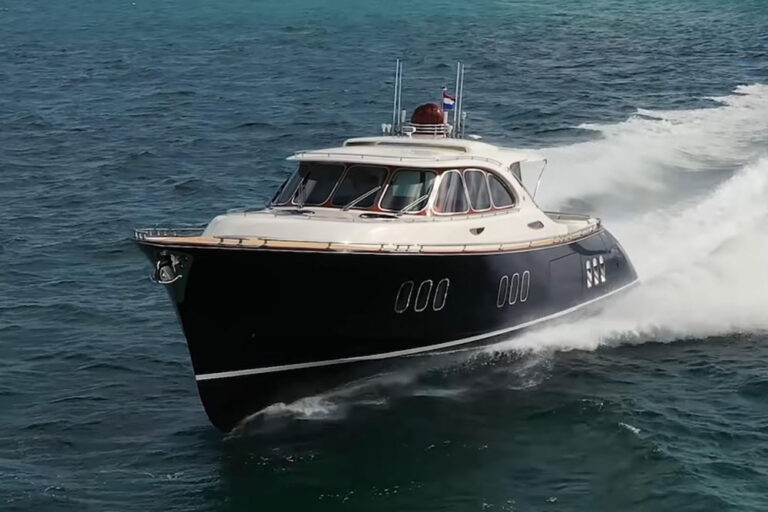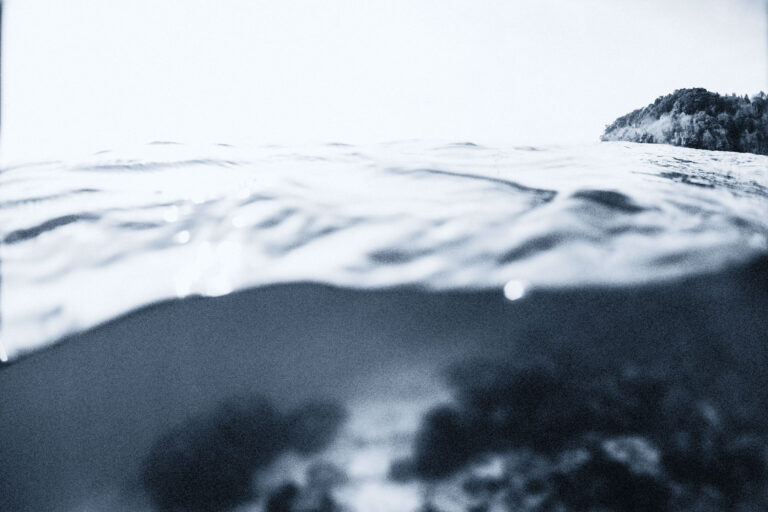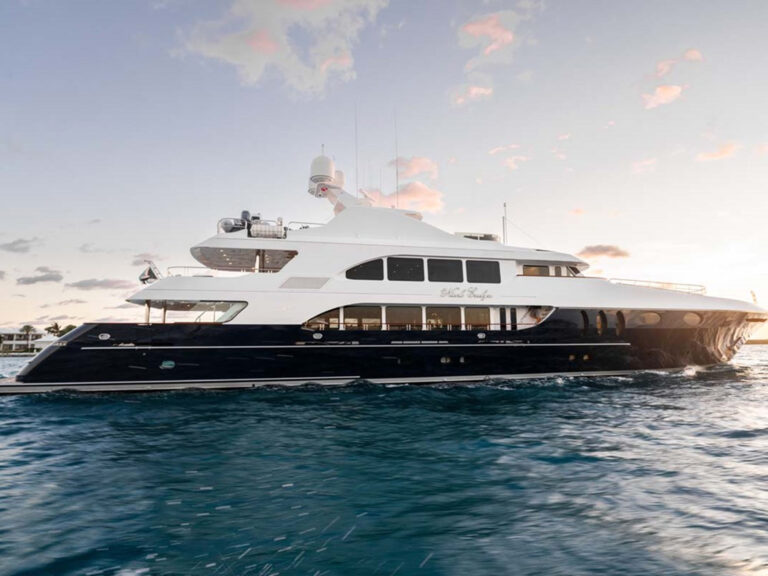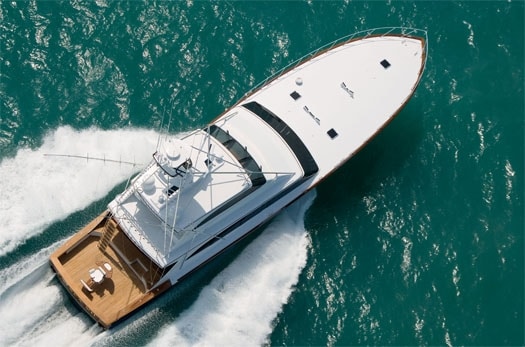
jimsmith861.jpg
In the world of go-fast tournament fish boats the Jim Smith brand has the patina of a well-seasoned legend. The first Jim Smith that passed me was Broadbill. When she was launched in the early 1980s most boats in the tournament fishing fleet could manage little more than 30 knots. With a pair of tweaked Detroit Diesel 8V-92s bolted to her lightweight cold-molded hull, she was capable of 45 knots. I thought of the Jim Smith legacy as I inspected the 86-foot Patsea VII, the latest boat to wear the badge.
To appreciate Patsea VII, it is important to understand the Jim Smith Boats bloodline. If legends in the yachting world are woven with threads of mystery, then Jim Smith’s story is a tapestry. “While he only had a sixth-grade education, Jim was intuitive when it came to design,” said John Vance, President of Jim Smith Boats. “Jim used to say he could see it in his imaginary mind…he really could!”
Smith’s background was eclectic. James Claude Smith was born in 1906 in Cherry Log, Georgia. He quit school after the sixth grade and took a job cutting wood. Wanting to make something of himself, he became involved in the “liquor distribution” business. Spending money in hand, he took an interest in barnstorming biplanes, motorcycle racing, and outboard race boats when “fast on the water” was 20 mph. Smith’s success in boat racing led to a Johnson outboard distributorship. Smith attempted retirement in Boca Raton, Florida, but his interest in the water led him to boatbuilding and charter fishing. One of his first efforts, the 35-foot Boca Jima built in 1959, demonstrated Smith’s passion for innovation. Cold-molded with double-diagonal cedar and epoxy resin, she was strong, lightweight, and capable of 44 knots. To enhance her aerodynamics, Smith designed a pod-like tower supported on four aluminum sailboat mast extrusions. Instead of a ladder, an elevator took the skipper aloft. This was a practical feature for Smith as a motorcycle crash had left him with a wooden leg. Vance suggested the design had another advantage. “Jim would leave the elevator in the up position while fishing so his charter guests wouldn’t bother him.”
Smith had no children and when he passed away in 1994, Vance kept the shop doors open. “I had always been interested in sailing and dreamed of building racing sailboats,” said Vance. “I never imagined I’d be building fishboats.” Vance grew up on Lake Erie and has sailed everything from Lightnings to Farr 40s.
“By the time I began apprenticing, competitive sailboat builders had moved to composites,” said Vance. “I wanted to work in wood.” At the time, Jim Smith was pushing the envelope in cold-molded construction, which appealed to Vance. “Smith had guts he read about the new epoxy resins in ‘Popular Mechanics,’ figured they were perfect for boatbuilding and gave them a try.” Other boatbuilders took notice. “Before John Rybovich passed away he admitted to me that he had underestimated Jim’s genius,” Vance noted. “John had been certain Jim’s boats would come apart.”
In the old days, boat design and engineering was more or less seat-of-the-pants. Jim’s rule was “never use more than you need but always use enough,” according to Vance. This simple credo still guides Vance’s approach today, although the new boats are carefully engineered. Patsea VII is one of two 86-footers Vance has launched-the first was an open-bridge design. The boats share a hull form designed by Donald L. Blount and Associates. The Blount firm was responsible for engineering the structure and sorting out the hydrostatics. PatseaVII was built using conventional cold-molded construction. Her triple-diagonal mahogany hull skin was cold-molded over a removable jig that held her bulkheads, web frames, and stringers in position. The jig was then removed and her interior and exterior surfaces were covered with two layers of biaxial fiberglass and epoxy resin.
“Blount is good,” said Vance. “Patsea’s boot stripe was painted before we put her in the water and she floated right on her lines.” Her displacement at half load is 105,000 pounds which is very competitive considering her 3,300-gallon fuel capacity and her 2,400-horsepower MTUs which have a combined weight of 20,000 pounds. Fitted with a full tower, a tender, and her owner’s gear aboard, she is capable of 43 knots. Loafing along at 31 knots (1770 rpm and 72-percent load), she burns 120 gallons per hour. According to Vance the key to Patsea VII’s performance is her slippery hull form, which features a moderate entry with slightly convex forward sections and a transom deadrise of 13 degrees. Propeller tunnels, a Blount specialty, shade about a third of her 38-inch, five-blade Veem propellers. The result is a draft of just 5 feet, 2 inches. “In the early days, Jim Smith boats were known for their speed, not their ride,” admits Vance. “Thanks to Blount, our new boats deliver both.”
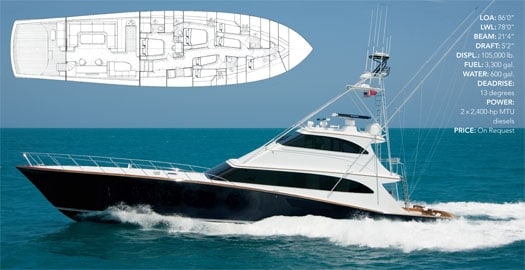
| | |
Kevin Hutchinson, a local (Stuart, Florida) landscape artist and boat designer, has worked with Vance on the last eight Smith boats and helped pen Patsea VII’s exterior styling and interior arrangement. Her dark-blue hull is highlighted by the aggressive sweep of her sheer forward. She has tumblehome aft, a pleasant traditional touch that is a relatively new feature for Jim Smith boats-concave topsides aft had been the norm-with the link perhaps being the developable surfaces Smith might have used early in his boatbuilding career. The clipper-like cut of Patsea VII’s stem and the slight knuckle where the chines intersect is standard Smith fare. While her angular superstructure has a bit softer look than earlier Smith designs, the cut of the house and window lines are unmistakable-she is pleasing to the eye and clearly a Jim Smith.
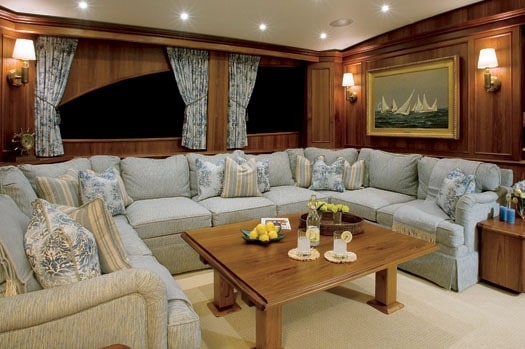
| | |
While exterior styling is Vance’s charge, the buyers determine interior layouts. “As the project progresses the owner plays more of a role in the creation of the boat and it’s important to me that we are all on the same page.” Vance fine-tunes his layouts on the shop floor by building a mockup for owners to walk through. Patsea VII’s owner needed accommodations for an owner’s party of eight-a master and three guest staterooms. There is an additional stateroom for Patsea VII’s crew of two. Her main cabin is open and has a large commercially equipped galley forward. Vance describes the interior theme as “Old English Library” and it features raised-panel teak joinery complemented by granite countertops and high-end soft goods and hardware. The final touch is a collection of breathtaking nautical art. The enclosed bridge is accessible from an exterior ladder on the cockpit mezzanine. The layout is conventional with the helm forward and a lounge area aft. An exterior balcony control station offers a view of the cockpit and is used while fishing.
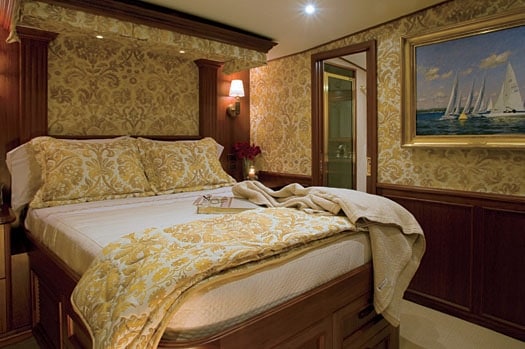
| | |
While time- and materials-driven projects are still common in the tournament fishboat market, Vance offers a fixed price for his boats. “Pricing is a simple math problem, a matter of figuring out the cost of the hundreds of tasks that go into building a boat,” he says. Vance’s 25 craftsmen usually work on two boats at a time, delivering one a year. They are currently working on a 70- and a 95-footer. “Being successful in custom boatbuilding is knowing when to stop,” explains Vance. “As Jim use to say, there is no sense in polishing the concrete under the boat. His point: don’t waste an owner’s money.”
Patsea VII was delivered to her owner in June-an experienced woman angler moving up from a 72-foot enclosed bridge convertible. Based in Stuart, Florida, Patsea VII will wander waters from New England to the Bahamas and south of the border. “In our business your marketing is your last boat and the customer you built her for,” said Vance. Patsea VII is a winner and her owner is pleased. I’m certain Jim Smith would be, too.
Jim Smith Boats, (772) 286-1172; www.jimsmithboats.net

